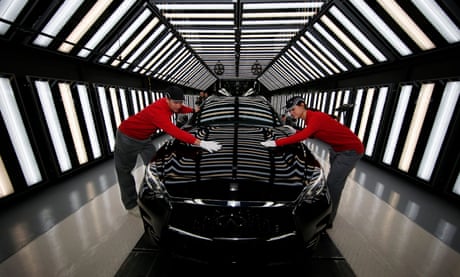Duncan Weldon in The Guardian
Without it the future is bleak, but despite a bewildering array of theories for why this key economic driver has dropped there is no clear answer
Illustration: Robert G Fresson
Our economic future isn’t what it used to be. In March the Office for Budget Responsibility (OBR) revised down its growth estimates for each of the next five years. The chancellor was quick to blame a weakening world economy but the true driver lies closer to home. The problem isn’t a loud global economic crash but something much quieter: engine trouble. Productivity growth, the long-term motor of rising living standards, is slowing. The fact that this appears to be happening across the globe offers scant consolation.
What’s worse is that no one is entirely sure what is causing the problem or how to fix it. And it is coming at about the worst time imaginable: global demographics are changing, with the supply of new workers set to slow and the older share of the population rising. The future is of course inherently unknowable, but the reasons for longer-term pessimism on economic growth are starting to stack up.
Productivity – the amount of output produced for each hour worked – rose at a fairly steady annual rate of about 2.2% in the UK for decades before the recession. Since the crisis though, that annual growth rate has collapsed to under 0.5%. The OBR has decided to revise down its future assumption on productivity from that pre-crisis 2.2% to a lower 2%. That small revision was enough to give the chancellor a large fiscal headache in his latest budget, but it still assumes a big rebound in productivity growth from its current level. What if that rebound doesn’t come?
The near death of the British steel industry is a tragedy. But for all the political heat it has generated, its long-term consequences wouldn’t be as serious as the wider crisis. For while closing mills are highly visible, slipping productivity is not.
Looking at the global picture shows that while there are of course national nuances, the overall impression is grim and dates back to before the 2008 crash. Everywhere from the “dynamic” United States to “sclerotic” France, productivity growth has dropped considerably in recent years. The UK is an outlier with a bigger fall than many, but not by much.
Some of this could be explained by measurement issues. To use every economist’s favourite example, it is straightforward to measure the inputs, the outputs – and hence the productivity – of a widget factory, even if no one is really sure what a widget is. It is harder to do the same with an online widget brand manager. But the mismeasurement would have to be on an unprecedented scale to explain away the problem.
Our economic future isn’t what it used to be. In March the Office for Budget Responsibility (OBR) revised down its growth estimates for each of the next five years. The chancellor was quick to blame a weakening world economy but the true driver lies closer to home. The problem isn’t a loud global economic crash but something much quieter: engine trouble. Productivity growth, the long-term motor of rising living standards, is slowing. The fact that this appears to be happening across the globe offers scant consolation.
What’s worse is that no one is entirely sure what is causing the problem or how to fix it. And it is coming at about the worst time imaginable: global demographics are changing, with the supply of new workers set to slow and the older share of the population rising. The future is of course inherently unknowable, but the reasons for longer-term pessimism on economic growth are starting to stack up.
Productivity – the amount of output produced for each hour worked – rose at a fairly steady annual rate of about 2.2% in the UK for decades before the recession. Since the crisis though, that annual growth rate has collapsed to under 0.5%. The OBR has decided to revise down its future assumption on productivity from that pre-crisis 2.2% to a lower 2%. That small revision was enough to give the chancellor a large fiscal headache in his latest budget, but it still assumes a big rebound in productivity growth from its current level. What if that rebound doesn’t come?
The near death of the British steel industry is a tragedy. But for all the political heat it has generated, its long-term consequences wouldn’t be as serious as the wider crisis. For while closing mills are highly visible, slipping productivity is not.
Looking at the global picture shows that while there are of course national nuances, the overall impression is grim and dates back to before the 2008 crash. Everywhere from the “dynamic” United States to “sclerotic” France, productivity growth has dropped considerably in recent years. The UK is an outlier with a bigger fall than many, but not by much.
Some of this could be explained by measurement issues. To use every economist’s favourite example, it is straightforward to measure the inputs, the outputs – and hence the productivity – of a widget factory, even if no one is really sure what a widget is. It is harder to do the same with an online widget brand manager. But the mismeasurement would have to be on an unprecedented scale to explain away the problem.
What we are left with is a bewildering array of theories as to what has driven the fall but no clear answer. We know the productivity slowdown is broad based and happening across most sectors of the economy. Lower corporate and public investment than in the past almost certainly explains some of the shortfall. Weaker labour bargaining power than in previous decades might also be playing a role. Low wages are allowing low-skill, low-productivity business models to expand and deincentivising corporate spending on new kit. Why spend on expensive labour-saving technology when labour itself is cheap?
But if you think you’ve found the full answer, you probably need to read more. There almost certainly isn’t a single explanation. It’s still perfectly possible to argue that productivity pessimism is overdone, that we are still suffering the lingering after-effects of the financial crisis that will eventually end. But with each passing year that becomes more difficult. A good strategy is to hope for the best but prepare for the worst. And the worst is pretty bad.
But if you think you’ve found the full answer, you probably need to read more. There almost certainly isn’t a single explanation. It’s still perfectly possible to argue that productivity pessimism is overdone, that we are still suffering the lingering after-effects of the financial crisis that will eventually end. But with each passing year that becomes more difficult. A good strategy is to hope for the best but prepare for the worst. And the worst is pretty bad.

George Osborne at the Airbus factory in Filton, Bristol. Photograph: Andrew Matthews/PA
Productivity growth is more than just a financial concept, it’s a balm that can soothe class conflicts and take some of the sting out of distributional politics. If a worker’s output rises by 2% without an increase in their hours, then giving that worker a 2% pay rise is relatively straightforward. If their productivity is flat then a 2% pay rise results in either a fall in profits or a rise in prices. A world of lower productivity is a world of more intense fighting over the more meagre divisions of economic growth.
Productivity is one of two key factors determining the trend growth rate of an economy; the speed limit at which a country can expand without pushing up prices. The other is population. Falling birth rates across the advanced economies created a demographic “sweet spot” that lasted from the late 70s until fairly recently. Fewer children meant a rising share of the population was of working age. But fewer children in the past means fewer workers today and rising longevity means a rising share of the population who are retired. Across the west, the amount of workers for each retired person is heading in the wrong direction. Increasing the retirement age and more immigration are both theoretical fixes, but the scale of both required to fundamentally change the picture is almost certainly politically impossible.
Slowing population growth and weaker expected productivity growth have led the US Congressional Budget Office to revise down its estimate of US trend growth from north of 3% in the 1990s and 2000s to closer to 2%. In the UK, policymakers once thought trend growth was 2.75% and have now cut that to 2.2%. Without a productivity bounce that could fall to closer to 1-1.5% in the coming years.

UK's productivity plan is ‘vague collection of existing policies’
Japan is the usual cautionary tale of what happens when growth slows. A country that had a financial bust, made policy mistakes in the aftermath and then experienced an ageing society. But at least productivity growth didn’t collapse. Headline economic growth was weak and the government’s debt burden has soared, but real incomes and employment held up well. Japanese demographic transition at the same time as a productivity crunch is the worrying possibility facing the west.
So what are policymakers to do? They could accept lower growth and concentrate on distribution. Of course the politics of redistribution are much easier when resources are growing. Lower growth also means that the public and private debt piles built up across the west in anticipation of a brighter future would be much harder to deal with. The obvious answer is to increase public investment. This alone wouldn’t solve the productivity crisis but it could help, and certainly wouldn’t hurt. At a time when government borrowing costs are near historical lows this is about as close to a free lunch as economic policy ever gets.
Finding ways to boost corporate investment is trickier, as there isn’t much in the way of direct policy levers open to government. Reforming corporate governance to encourage more long-term decision-making could help. And while economists tend to assume that productivity growth leads to wage growth, there could be circumstances in which the relationship is inverted. The government’s new national living wage may act as a spur to improve productivity as businesses see their cost-base rise.
But if productivity remains low then difficult choices lie ahead. We’ll need either a substantially smaller state with less generous social security, or higher tax revenues as a share of the economy. That means raising the kind of taxes that bring in substantial sums – VAT, national insurance and income tax.
Neither a smaller state nor higher taxes are likely to prove popular. But governing in a lower-growth world was never going to be easy.

No comments:
Post a Comment